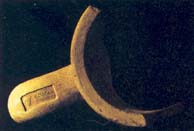Hellenistic Potsherds: What Jar Handles Can Tell Us
Sidebar to: In Search of the Jewish Diaspora

The most striking architectural feature in the square assigned to me was a Byzantine drain system. As we dug deeper, however, puzzling architectural fragments began to appear; so we sank several probes to learn more about the drain. In one probe, we found densely packed pottery, including numerous stamped amphora handles. The pottery dates to the Hellenistic Period (225–175 B.C.E.)—hundreds of years before the drain was built.
What was Hellenistic pottery doing in a Byzantine drain?
Previously we had discovered part of a Hellenistic wine press. The pottery and the wine press fragment must have been removed from a nearby disused Hellenistic wine-making facility and re-used to bolster a wall.
The predominance of amphora handles among the pottery is not surprising. In ancient port cities, amphoras were used to ship wine, oil, pitch, preserved fish and such dry goods as nuts and cheese. They also served as funerary urns and, with one side of the amphora cut open, as children’s coffins. The sherds of broken amphoras could be used as fill—to level land for buildings, or to close up unused wells or, as in our case, to buttress a drain.
Already a library member? Log in here.
Institution user? Log in with your IP address.

